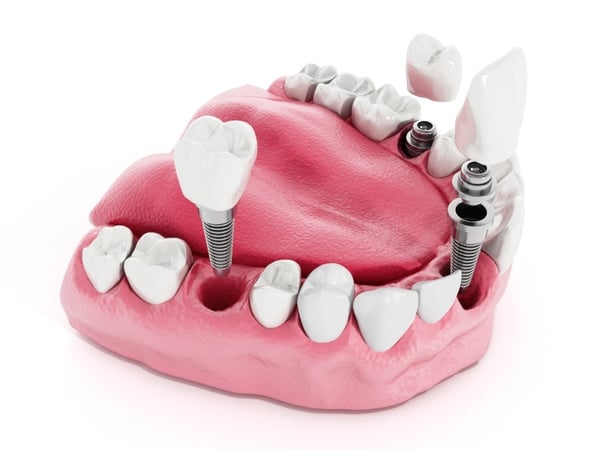
People whose mouth no longer supports rooted teeth because of extensive gum and bone weakness (said to be (Edentulous or soon-to-be-edentulous) can still have a strong set of implanted teeth through new procedures. Where gums are not strong enough to support independent implants, several artificial teeth can be bridged to a single anchor tooth.
How is this possible?
The All-on-Four dental technique uses only four implants for a complete set of teeth. Conventional implants require between six and eight anchored implants or more anchor an "arch" of teeth.
Where bone is lost, the problem solved by these new procedures is to maximize the contact with remaining bone by placing the teeth on an angle. Conventional tooth implants often require bone grafting to strengthen the anchor points in the mouth. The All-in Four procedure usually requires no bone grafting.
How long has the All-on-4 procedure been around?
Dental implantation is part of the general discipline of osseointegration, which refers to the science of fixing prosthetic devices directly into bones.
The techniques of getting the body, the bone, to accept a titanium metal plug as if it were part of the bone was developed at the laboratory of vital microscopy at the University of Lund and at the laboratory for experimental biology at the University of Gothenburg in the early 1950s.
The procedure requires precise surgery to shape the bone around the implant so that after a healing period, a shell of bone would form around the implant.
The first application of the process to dentistry was performed for a patient in 1965. This was, interestingly, not a single tooth implant, but a full arch of artificial teeth supported by only four implants (an All-on-Four procedure). It took 20 years of experimentation to develop a screw-shaped implant made of pure titanium.
The implant has an outer diameter of only 3.7 mm and a length of only 10 mm. This implant could fit almost any edentulous jaw.
The aim of All-on-Four.
From the beginning, the dental and medical scientists who have been developing and perfecting dental implantation were aiming for complete functional restoration. They were not happy with the safer and easier procedure of single implantation.
All-on-Four restores normal dental functioning in an entire arch of teeth. If you receive an All-on-Four implantation procedure for your lower teeth and your upper gums and jaw are in danger, most dentists will recommend that you get both upper and lower dental arches done at once to save time, money, and to keep you dental functioning optimal.
What will happen?
The All-in-Four procedure is serious dental surgery that involves the use of central nervous system anesthetic. The first appointment with your dentist will be to evaluate the condition of your mouth. You will probably receive a dental CT scan to allow the dentist to view your oral bone structure. The dentist will consider your general health to evaluate your surgery risks.
The dentist and technicians will work with you to make sure the teeth you get will have the shape, color, and size of your original teeth so that they will look absolutely natural.
Generally, the procedure of implantation only takes one day. When you leave you will be fitted with a temporary set of teeth attached to the implants. Since this is dental surgery, you can expect there will be a recovery period during which you may experience some discomfort.
You will be given a soft food diet over a period of up to a few weeks to allow your implants to heal. After that, you will be able to return to a normal diet. Six months after the procedure, you will return to the dentist to receive your permanent teeth.
William Linger, DDS, MAGD offers a dynamic combination of advanced technologies in one convenient location. Please contact us to learn more.



